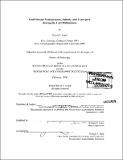| dc.contributor.advisor | William B. Curry. | en_US |
| dc.contributor.author | Lund, David Charles | en_US |
| dc.contributor.other | Woods Hole Oceanographic Institution. | en_US |
| dc.date.accessioned | 2006-11-07T13:02:31Z | |
| dc.date.available | 2006-11-07T13:02:31Z | |
| dc.date.copyright | 2005 | en_US |
| dc.date.issued | 2006 | en_US |
| dc.identifier.uri | http://hdl.handle.net/1721.1/34567 | |
| dc.description | Thesis (Ph. D.)--Joint Program in Oceanography (Massachusetts Institute of Technology, Dept. of Earth, Atmospheric, and Planetary Sciences; and the Woods Hole Oceanographic Institution), February 2006. | en_US |
| dc.description | Includes bibliographical references. | en_US |
| dc.description.abstract | Benthic and planktonic foraminiferal [delta]18O ([delta 18Oc) from a suite of well-dated, high-resolution cores spanning the depth and width of the Straits of Florida reveal significant changes in Gulf Stream cross-current density gradient during the last millennium. These data imply that Gulf Stream transport during the Little Ice Age (LIA: 1200-1850 A.D.) was 2-3 Sv lower than today. The timing of reduced flow is consistent with cold conditions in Northern Hemisphere paleoclimate archives, implicating Gulf Stream heat transport in centennial-scale climate variability of the last 1,000 years. The pattern of flow anomalies with depth suggests reduced LIA transport was due to weaker subtropical gyre wind stress curl. The oxygen isotopic composition of Florida Current surface water ([delta]18Ow) near Dry Tortugas increased 0.4%0/ during the course of the Little Ice Age (LIA: -1200-1850 A.D.), equivalent to a salinity increase of 0.8-1.5 psu. On the Great Bahama Bank, where surface waters are influenced by the North Atlantic subtropical gyre, [delta]18Ow increased by 0.3%o during the last 200 years. Although a portion (-O. 1%o) of this shift may be an artifact of anthropogenically-driven changes in surface water [Epsilon]CO2, the remaining [delta]18Ow signal implies a 0.4 to 1 psu increase in salinity after 200 yr BP. | en_US |
| dc.description.abstract | (cont.) The simplest explanation of the [delta]18Ow, data is southward migration of the Atlantic Hadley circulation during the LIA. Scaling of the [delta]18Ow records to salinity using the modern low-latitude 180,w-S slope produces an unrealistic reversal in the salinity gradient between the two sites. Only if [delta]18Ow is scaled to salinity using a high-latitude [delta]18Ow-S slope can the records be reconciled. Changes in atmospheric 14C paralleled shifts in Dry Tortugas [delta]18Ow, suggesting that variable solar irradiance paced centennial-scale Hadley cell migration and changes in Florida Current salinity during the last millennium. | en_US |
| dc.description.statementofresponsibility | by David C. Lund. | en_US |
| dc.format.extent | 256 p. | en_US |
| dc.format.extent | 27095353 bytes | |
| dc.format.extent | 27094557 bytes | |
| dc.format.mimetype | application/pdf | |
| dc.format.mimetype | application/pdf | |
| dc.language.iso | eng | en_US |
| dc.publisher | Massachusetts Institute of Technology | en_US |
| dc.rights | M.I.T. theses are protected by copyright. They may be viewed from this source for any purpose, but reproduction or distribution in any format is prohibited without written permission. See provided URL for inquiries about permission. | en_US |
| dc.rights.uri | http://dspace.mit.edu/handle/1721.1/7582 | |
| dc.subject | Joint Program in Oceanography. | en_US |
| dc.subject | Earth, Atmospheric, and Planetary Sciences. | en_US |
| dc.subject | Woods Hole Oceanographic Institution. | en_US |
| dc.subject.lcsh | Ocean-atmosphere interaction | en_US |
| dc.subject.lcsh | Paleoclimatology | en_US |
| dc.title | Gulf stream temperature, salinity and transport during the last millennium | en_US |
| dc.type | Thesis | en_US |
| dc.description.degree | Ph.D. | en_US |
| dc.contributor.department | Joint Program in Oceanography | en_US |
| dc.contributor.department | Woods Hole Oceanographic Institution | en_US |
| dc.contributor.department | Massachusetts Institute of Technology. Department of Ocean Engineering | |
| dc.identifier.oclc | 71196904 | en_US |
